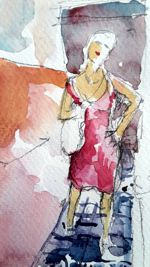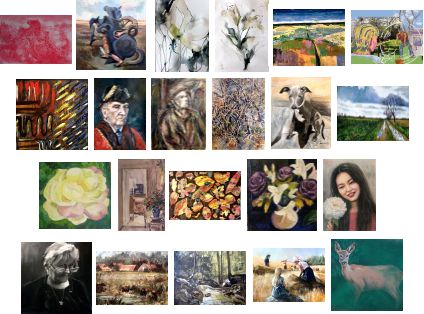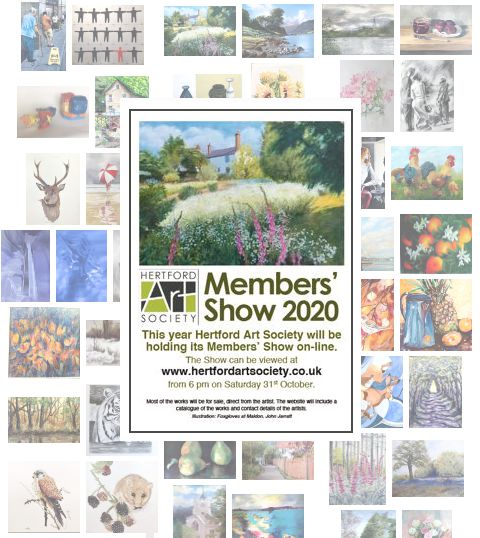Linocut Workshop with Jude O’Sullivan
7th December 2021
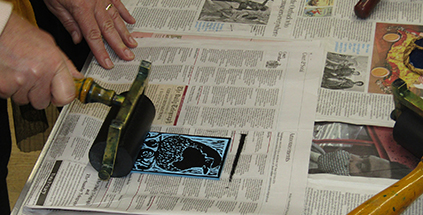

Jude O’Sullivan started her career as a graphic designer, then progressed to teaching graphics and printmaking in the Further Education sector. She currently runs classes in all forms of printmaking at Courtyard Arts in Hertford.
Jude had asked us to come prepared with a simple design drawn out to within a size of A6 (105mmx148mm) as well as an HB pencil, a biro and greaseproof paper or baking parchment to cover the wet prints for transport home. The aim of the workshop was to show how to prepare and print a simple design from soft cut Lino. We took our designs, traced them onto the blue lino (kindly suppled by Jude). There are many different colours, but blue is the softest. Jude equipped us with the soft cut lino plate, tracing paper, cutters, printing ink, roller and paper to print on.
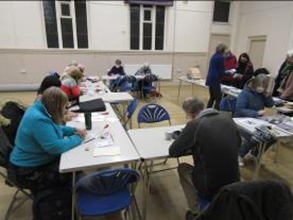
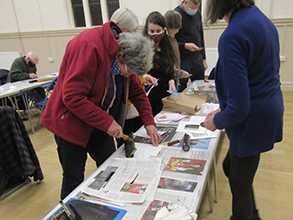
We went over the tracing with biro in order that the image would not rub off whilst cutting. Jude also supplied the cutting tools, roller and ink. Depending on your choice of cutting tool a variety of marks can be made, from very fine lines to larger marks allowing areas to be cleared more quickly. It takes practice and concentration as you are working to leave the correct bits of lino intact. The biro marks certainly helped with this.
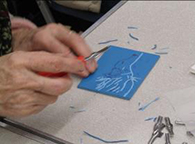
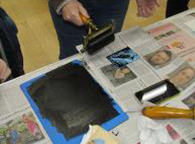
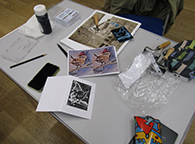

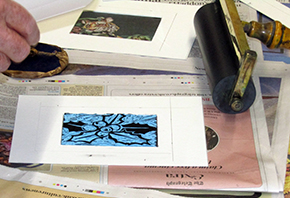
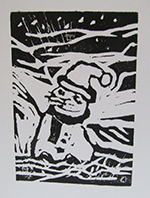
The next stage was loading the right amount of ink onto the roller and then onto the linocut. (This workshop used only black printing ink.) We were able to do some test runs before committing the print to the cards. This enabled any small corrections to be made. She had prepared packs containing one sheet of A4 soft cut Lino, a small roller, one tube of black ink and a pack of cutters for sale were ideal for anyone who would like to continue making plates and printing at home.
Jude supplied us with cards to print our images one, some of which she had already collaged with gampi paper (Japanese tissue, which is strong). This made our cards much more exciting as you can see from the images. Jude gave tips and advice throughout and was warmly thanked for running this interesting and challenging workshop.
Demonstration by Roger Dellar
An Interior in Oils - 30th November 2021
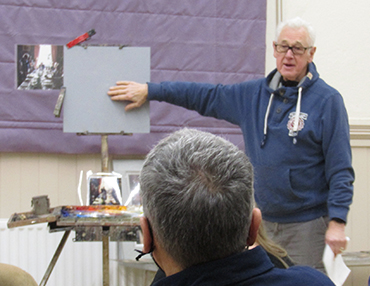

We were delighted to welcome Roger Dellar back for a further demonstration. Roger is a member of The Royal Institute of Oil Painters, The Royal Institute of Painters in Watercolour and The Pastel Society and an active member of the Wapping Group. Roger teaches students in various venues and on holiday courses. He has a keen interest in people and their behaviour and is fascinated by the way the play of light transforms a subject.
Roger introduced us to his favoured materials: a board primed with gesso tinted a mid grey, his large palette with warm and cool versions of the three primary colours, burnt umber and Titanium white, painting medium of linseed oil blended 50/50 with Damar Varnish, a range of brushes and white spirit for cleaning. Roger favours three quarter length brushes as he feels that long brushes create too much distance and “wobble” when using.
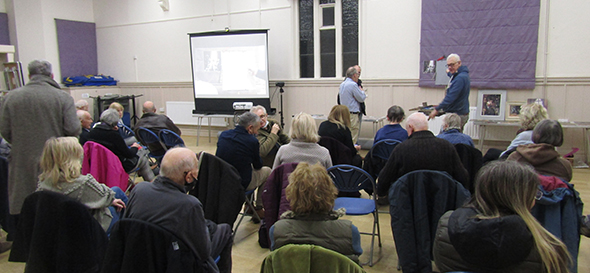
A photograph of a lunch party was the chosen image. There was strong back lighting from a tall window leaving many of the figures in dark tones with light silhouettes and the shot was from the end of a rectangular table, providing acute angles of perspective. The first stage was for Roger to draw the main elements using a thin Burnt Umber mix and a fine brush. This was followed by blocking in some of the strong dark elements. Roger works from “lean” to “fat” with the underpainting worked in thin layers. Throughout the demonstration Roger explained his approach and method of working while entertaining us with anecdotes of his experiences in tutoring students, painting plein air and the various characters in the photograph of the lunch he had attended.
Having laid down the dark tones, Roger began placing the lights, using warm and cool tones. This detailed the layout of the table and the forms of the figures around it. He worked around the painting and continued to add additional dark and mid tones, defining the heads and figures. He laid the paint on lightly with bold strokes and worked for some time on the window in the background, first with pale yellow shades and then settling for cooler tones. This area was broken up with a hint of a plant in the window.
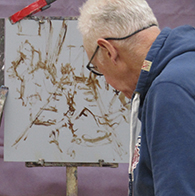
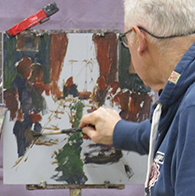

Partway through the process, Roger used a rubber tipped shaper to etch into the paint, definite faces, edges of figures, redrawing some elements to assist when continuing to paint. He emphasised the need to step back and evaluate how the tones and forms were working.
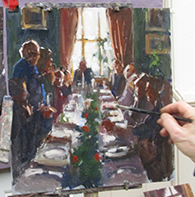
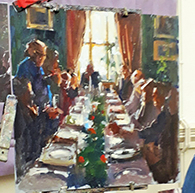
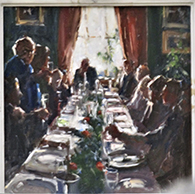
As the painting progressed Roger applied the paint in thicker strokes. He used warm shades on the curtains around the window, echoing these shades in faces and hands. A fine brush defined the edges of transparent glassware, candles etc. and the centre table display was enhanced with red baubles. Gradually the painting came together. The strong light is a feature of Roger’s style of painting and really brought life to the painting and form to the figures. The final version was full of life and subtle colour.
Roger was warmly thanked for this demonstration and for sharing his expertise with us. This was a very enjoyable demonstration. Roger’s enthusiasm and the energy he brings to his work is really inspiring.
Painting birds with water-based paints
Workshop with Suzy Drake - 16th November 2021
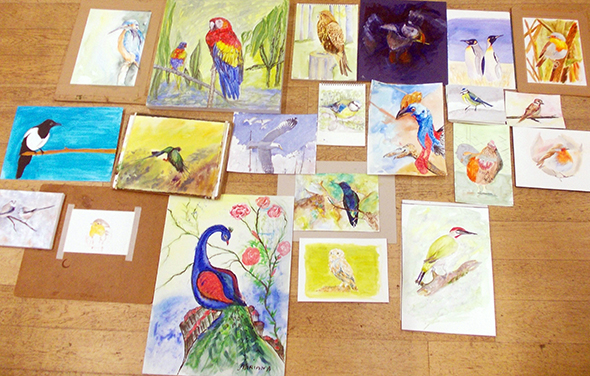
Suzy Drake is a Mixed Media Wildlife Artist who exhibits regularly, works on commissions for different clients and also teaches a wide range of art/craft subjects to different ages and abilities. Suzy has a degree in scientific illustration and her work is inspired by wildlife and landscape, using a range of technique and media which convey her love of the natural world and the abstract qualities of shape, pattern and colour in that world.
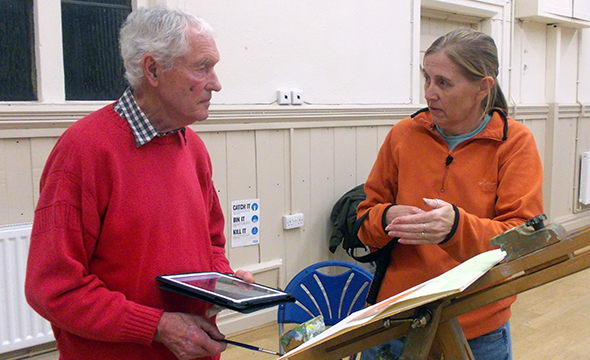
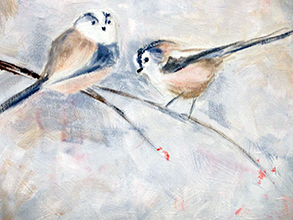
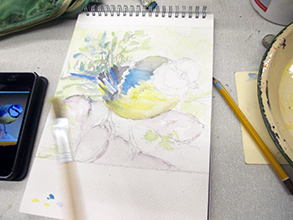
We had been asked to bring our chosen medium and prepare for the workshop with a photograph of a bird sketched on watercolour paper or a suitable surface for acrylics. Suzy began by showing us a selection of her work and talking about the importance of the space around our chosen subject. She finds it helpful to work with both the background and the subject rather than just focusing on the subject (in this instance, birds) and then “filling-in” the surrounding paper as a bit of an afterthought. Suzy also recommends plenty of thinking time both ahead of starting work and during the process.
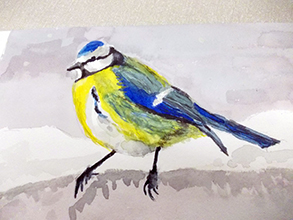
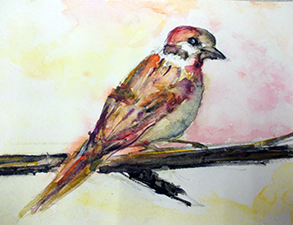
During the workshop Suzy spent time with each artist giving helpful tips and advice. Painting birds was quite a departure for many of the artists but it was challenging and interesting. The images below show the colourful work at various stages.
Suzy was warmly thanked for running this enjoyable Workshop and for sharing her expertise and enthusiasm for working in this field.
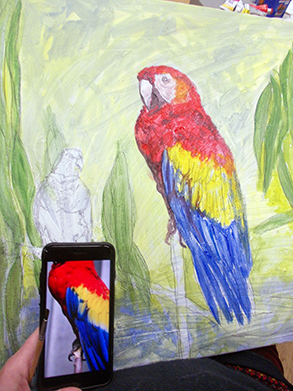
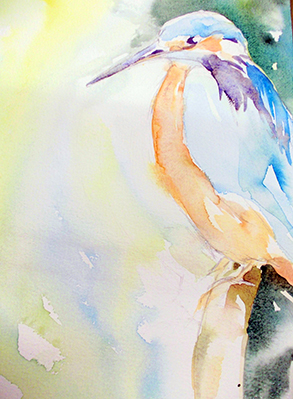
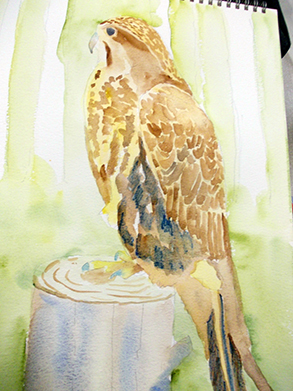
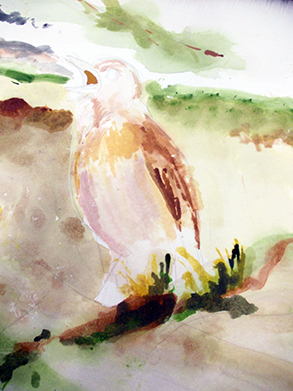
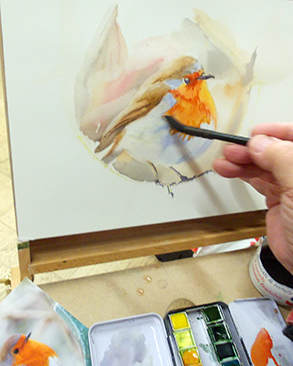
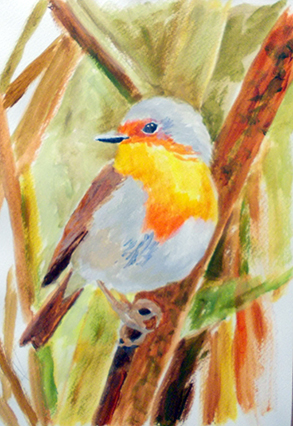

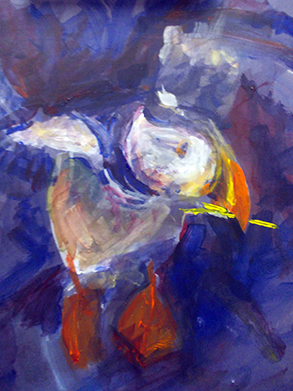
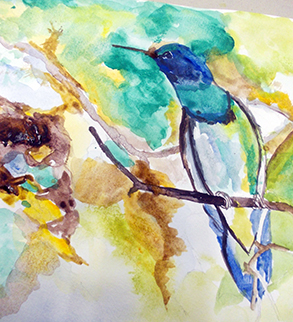
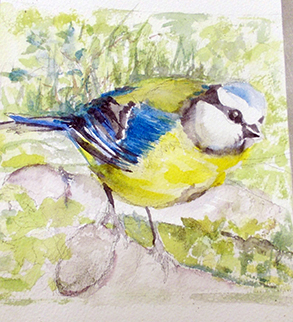
2020-2021 Critique Winners
Critique winners of the 2020 – 2021 season as chosen by Members
 David Stowe September 2020 Joint Winner Insularity - Oil |
 Kathy Burman September 2020 Joint Winner M Hotel, London - Collage |
 Stephen Lowe September 2020 Joint Winner Pollinating the Roses - Oil |
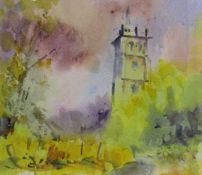 Michael Radley October 2020 Winner All Saints' Church - Watercolour |
 Mitiko Murata November 2020 Critique Winner Abstract of Inner Feeling |
Summer Programme 2021
Sketching and Painting at local venues
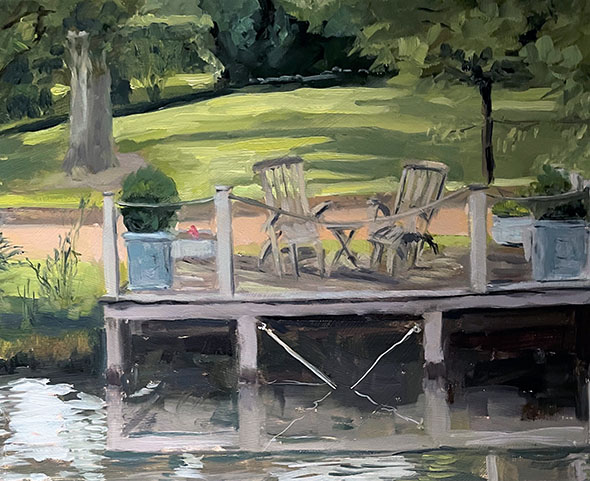
Our Society’s twelve Summer outdoor sketching evenings this year were enjoyed by Members in varying degrees. This was reflected in the weather conditions encountered, which ranged from “cold/dull” to “warm/balmy”. The Programme included venues around Hertford and Ware, the charming pond at Chapmore End and Walkern Village. The evening spent painting in Sacombe Park for instance was truly a welcome summer evening. Another such sunny evening was our visit to Haileybury College where we were kindly allowed to paint until 9pm.
On three evenings Members were invited to visit and paint in Members’ gardens and we were all appreciative of the hospitality received. On the final evening fourteen members rounded off the Summer sketching evenings with a convivial meal at the Salisbury Arms in Hertford.
This is a selection of sketches and paintings produced by Members.


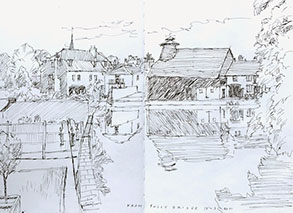
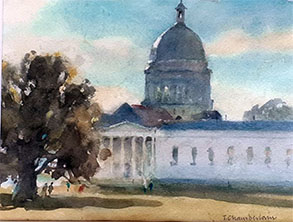
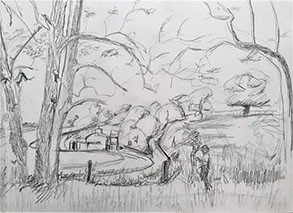

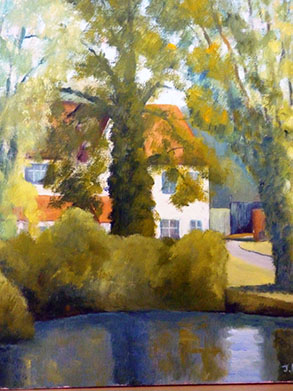

“Try a new format” - Untutored Online Workshop
16th February 2021
“Format is traditionally used to describe the shape or proportions of the support, for example the canvas, of a painting or other essentially flat work of art such as a relief.” (Tate website)
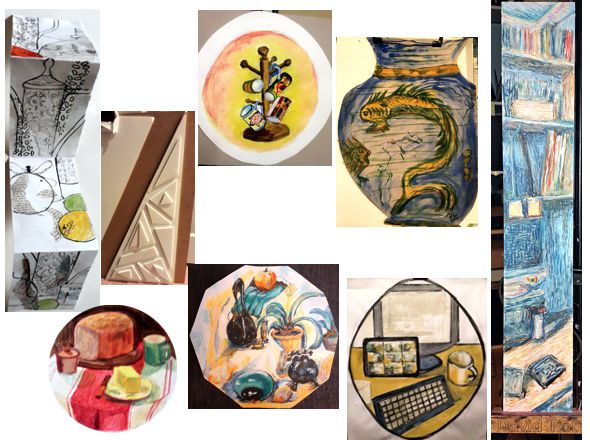
In creating a picture, the shape of the paper or canvas is an important part of the composition. Most pictures are traditionally rectangular or square, but there is no rule to say that a picture cannot be any other shape.
Our challenge on 16th February was to try out a new and unusual shape of paper or canvas and for those who were unable to join this on-line workshop it is certainly worth spending some time on this exercise.
If you have never before drawn a circular picture, then this is your great opportunity (e.g. try drawing around a plate to create the boundary for your image). Or you could paint your image within an oval boundary. Or perhaps you would like to try working on a very narrow, tall support. Or on a very, very wide support. If you have previously tried all of these, then you might like to attempt something even more unusual. How about a triangular picture? Or an “organic” freeform image? For a bit of inspiration, please see the images below.
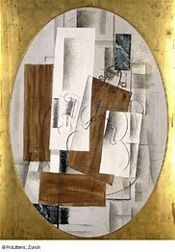


The suggested subject for our drawing evening was perhaps a “still life”, a corner of your own interior space or something from your imagination. So it’ll be a familiar subject but an unusually-shaped picture. This DIY workshop sets out to give you plenty of choice in what you do, whether figurative or abstract.
Any medium is suitable together with one or more pieces of paper, canvas or board cut to a new and original shape.
The only rule is that the picture mustn’t be square or rectangular!
Although an untutored Workshop, Marianne Dorn welcomed the artists to the Zoom session and introduced the topic of “Format”, mentioning works over the ages which have departed from the norm. There was a break for discussion partway through and at the end of the evening we looked at the work produced and discussed how we got on with this project. A great variety of formats was chosen and the evening produced very interesting artworks - painting, drawings and 3D. This is certainly a worthwhile exercise in thinking outside the box. Marianne was thanked for organising this very interesting and enjoyable Workshop.
The Philosophical Painters Group

The Philosophical Painters Group (often referred to as the PP’s ) Which I joined in 2011 was started by Stella Hunt with the idea of pushing the boundaries of the members work and hopefully breaking new ground by being inspired by each other and trying different techniques. The consequence of which would be improving our standard of work. The Philosophical element in the name reflects our ideas on the subject set, rather than the object(s).
When it started there was a mix of artists from Enfield area and Hertford Art Society but now the members are all members of Hertford Art Society. We keep the membership to approx. 16 as this means we have time to learn from one and other. We are given 2 weeks to think about and prepare between each meeting where we proceed to produce a painting. We meet for 3 hours on a Friday and at the end of each session we spend 30 mins looking at and discussing our piece of work. The following images were on the topic of “Patterns in Nature” and illustrate the broad range of ideas resulting from this initial theme.
Because Stella Hunt has found it more and more difficult to manage, we have become a loose collective, where we all take our turn, where we can, to help run the group.
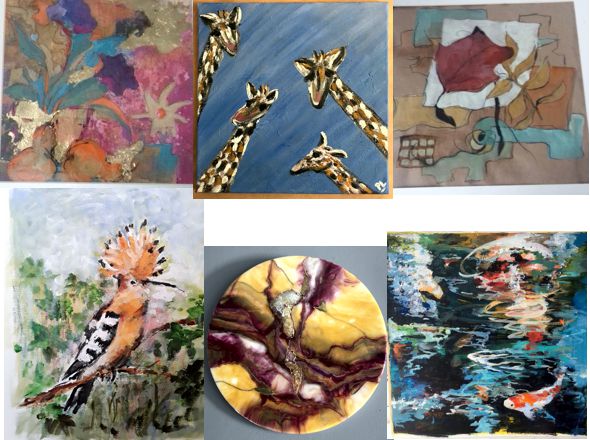
Because of Lockdowns we have moved onto the internet with the same programme except once a fortnight we send our work to the designated member, who assembles them and sends the collection out to all members.
In the absence of a discussion, we send our comments over the internet so are still learning.
It has worked so well for all of us that it is the highlight each fortnight to receive the collection. June Pickard
Many Hertford Art Society Members work with other local groups and we hope to feature these in the future.
Online Life Workshop - 30th January 2021
One of our regular models, offered to undertake our January 2021 Life Workshop via Zoom from her home which made it possible to reinstate this Workshop. The model did an amazing job in structuring a very challenging and enjoyable workshop. These are comments from some of the Members who took part together with a selection of images of their work.
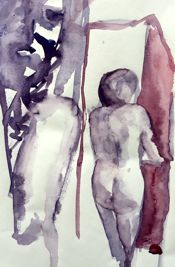
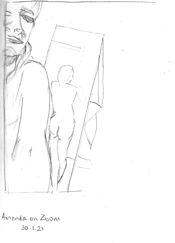
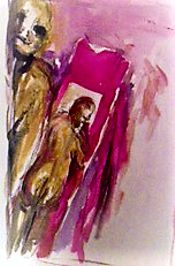
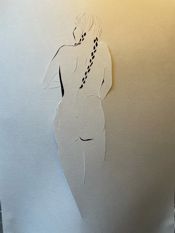
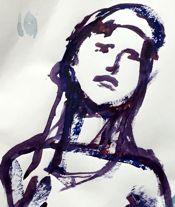
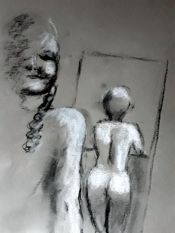
“An excellent model. She organized the session very efficiently with a great variety of poses. I would be very happy to have her again.” Pat Mann
“I liked the Zoom session much better than I expected. The model is a natural, even on camera! I particularly liked the foreshortening effect of the model stretching towards the camera – the lens seems to elongate the near view. By & large everyone kept background noise to a minimum so I didn’t feel the need to mute everyone, and it meant we got a bit of chat from time to time which was nice.” Geoff Bennett
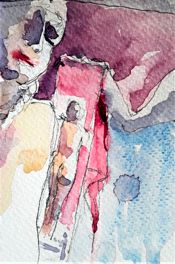
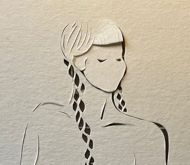


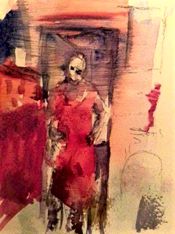
“I thought the session was very good and worked very well. A longer pose for painting would be appreciated in any future sessions. Jim Gooch
 “I tried something new this time, I wanted to really slow myself down and push myself to focus on the form. Life is crazy for me at the moment with work and home schooling, etc, so the aim was to make myself 100% aware of the cuts I was making. I used my scalpel to sketch rather than drawing any of it in graphite first. It was fascinating to do and not something I’ve done before.” Nicola Dobrowolski
“I tried something new this time, I wanted to really slow myself down and push myself to focus on the form. Life is crazy for me at the moment with work and home schooling, etc, so the aim was to make myself 100% aware of the cuts I was making. I used my scalpel to sketch rather than drawing any of it in graphite first. It was fascinating to do and not something I’ve done before.” Nicola Dobrowolski
“Enjoyed the session very much” Mikito Murata
“I haven't sketched for a long time, unsure what I would manage, particularly as the Zoom Life Workshop was a totally new experience. The model in her own home, created imaginative moves of various lengths of time. We were told when a position was to change, all in a professional manner. The decor was a treat too. I enjoyed the zoom session and look forward to the next one.” Margo Ward
“Very enjoyable” Chris Baker
“I enjoyed the session though was too slow with the 5 min sketches but with practice, I hope to simplify the basic lines and hope to improve. It was a fun morning! On the mirror picture - Not quite sure if it is possible to make out what is happening here, but it was fun to try! Carol French
“She was terrific very imaginative with her poses.” Ray Ward
“The model made brilliant use of various rooms in her home to conjure up imaginative poses for us. This was a great opportunity for us to respond to a life model within various interesting interior settings, and with the added personality of her own chosen backdrops.” Marianne Dorn
From Reality to Abstract
Online Workshop with Nick Harrison Jones - 26th January 2021
Nick Harrison Jones studied Graphic Design and has won several awards for his paintings. In his work he focuses on a combination of observed architectural, landscape and abstract elements, based on drawing and technical experimentation.
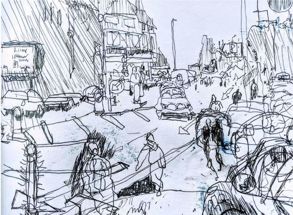
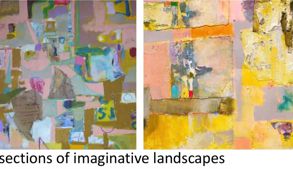
Work by the host, Nick Harrison Jones.
Nick conducted a workshop entitled ‘From Reality to Abstract’, aimed at getting us painting abstract pictures. It was Nick’s first tutorial conducted via Zoom and it turned out remarkably well – below is a shot of 14 households, most displaying the fruits of the evening’s endeavours, plus Nick front and centre.
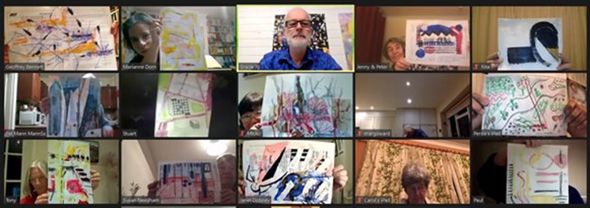
Nick got us into the zone by asking us to imagine a beautiful park framed by a couple of foreground trees. We were given 10 minutes to capture the scene with a paint sketch. For the second version Nick asked us to walk through the park in our mind, picking up not just the sights but also the sounds, the smells, the textures. He asked us to think about linear shapes (distant buildings perhaps) and how we might also introduce circular shapes (the sun, a bouncing ball). We should think about how we might use the edges of the paper and about spaces in the composition. Nick suggested we paint on photocopied sheets to add further interest.
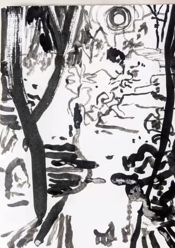
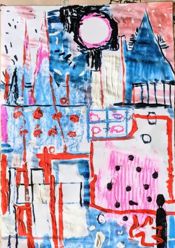

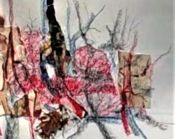
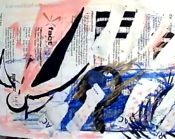
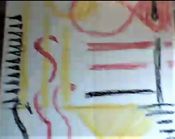
We were then invited to make a third painting, looser than the second, bringing together the above points to give a total experience of our imaginary walk.
The result was a rich array of wildly different abstracts and a thoroughly enjoyable evening.
January 2021 Critique
Each month Members are invited to submit a recent artwork to a Critique session with a professional artist, tutor or art critic. The January 2021 critique took place via Zoom and was hosted by Jean Noble RI SWA, a renowned abstract artist.
For full gallery, click here for more details.
Lockdown Diaries
Artworks and comments by Members of Hertford Art Society
2020 has been a memorable year. With the UK in lockdown from March due to Coronavirus Pandemic and the balance of the Winter and Summer Programmes 2020 of activities cancelled, leisure activities became restricted. Members of Hertford Art Society were invited to contribute photographs of artworks and comments to the Society’s magazine in order to share their experiences. As things stand, it has been possible to launch the Winter Programme 2020-2021, with appropriate restrictions.
This is a selection of the work produced over the Spring and Summer by a number of our Members together with their comments on the impact of the lockdown.
47 image gallery, click here for more details.
London Road Underpass, Hertford Murals
by Members of Hertford Art Society - Formally opened 8th October 2020
Ten Hertford Art Society artists have helped the transformation into an art gallery of the London Road subway near the fire station in Hertford. Their pictures, considerably enlarged, line one side of the subway. This project supports the Hertfordshire Year of Culture 2020.
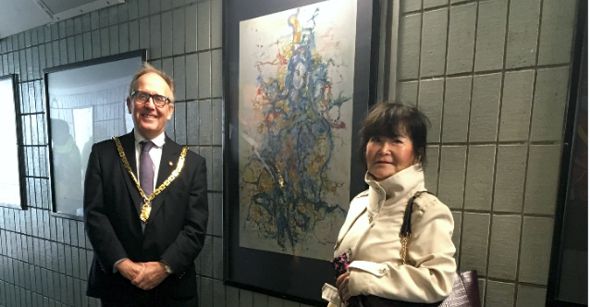
This mini-show was formally opened on 8th October by Hertford Mayor Bob Deering, seen here with Mitiko Murata and her picture ‘Mother Earth.
The other artists and their pictures are:
- Porto - Kathy Burman
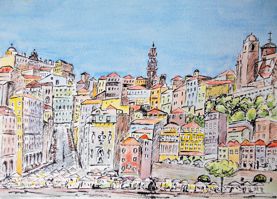
- Mother Earth - Mitiko Murata
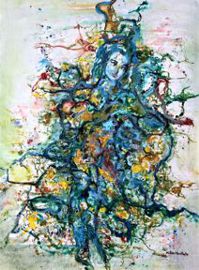
- The Mount - Diane Loan
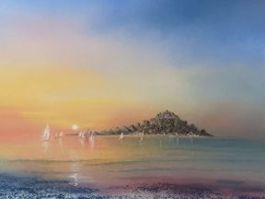
- Water Lily 3 - Sally Steele

- Poppies - Lynne Lawrence

- Calm Glade - Diane Warburton
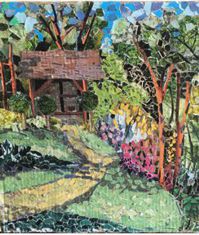
- Towards Ware - Chris Hewitt

- Colourful Bird - Laura Blight

- Venice - Oksana Melenevska
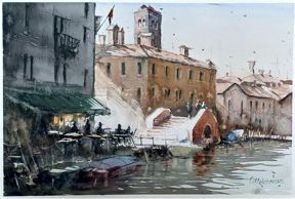
- Relaxing - Angela Roberts
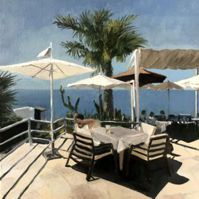
Congratulations to all ten artists.
Lining the wall opposite the HAS pictures are works by Alan Davie, an internationally acclaimed artist who for 50 years lived and worked at Rush Green, Hertford.
The refurbishment of Hertford’s subways is part of a County Council led programme to encourage more walking around Hertford.
Hertford Art Society Members’ Show 2020
This year our traditional autumn Members’ Show is online.
Pastel Demonstration by John Tookey
22nd September 2020
East Anglian artist John Tookey resides in the picturesque market town of Saffron Walden, Essex. John trained in Graphic Design and Fine Art at the Sir John Cass School of Art in London during the Sixties. He is justly famous for his dynamic, bold watercolours and pastels that sparkle with light. He has exhibited work with many prestigious galleries, is an author and tutor and a Member of the Pastel Society. John works in all mediums and trys to capture the essence of the subject rather than a very topographical likeness. He will frequently work on-site or from sketches completed at the scene, the effects of light and atmosphere on a subject particularly interest him.
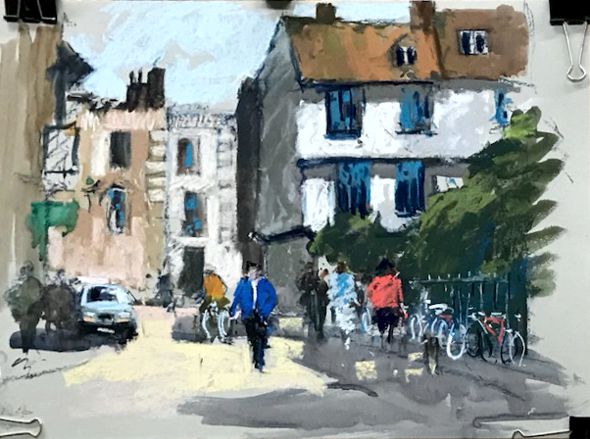
30 HAS members filed into our Cowbridge Hall that was well prepared with CV19 restrictions; it looked like an exam room as the chairs were placed at the required distances. It was good to see familiar faces - partially - as we were all “masked up” as necessary.
John started by informing us about the “Mount Board” he uses that suits this medium, because it doesn't cockle when a water-based paint is applied. He used a grey board as a good neutral base for the picture he was going to demonstrate - “A Street Scene in Cambridge” which he frequents with his sketch book as it is vital to have a sketch from which to produce a picture. He advised that even if we plan to paint from a photograph it would be a good idea to make a sketch of the photo first.
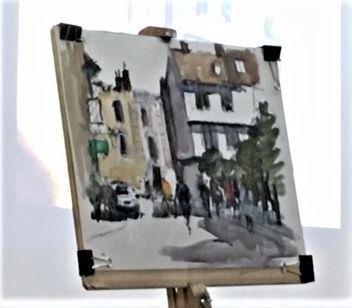 The pastels he had were the softer quality as, in his view, the harder ones are not worth buying. “Choose the softest that you can afford”, he suggested. Always make notes of the colours as you sketch for future reference. He attached his sketch to the edge of the mount board and started to draw the outline of the street scene with a thin dark pastel; he said one could use a pencil or charcoal for this too. He went back and forth from the board to check that this outline was correctly proportioned.
The pastels he had were the softer quality as, in his view, the harder ones are not worth buying. “Choose the softest that you can afford”, he suggested. Always make notes of the colours as you sketch for future reference. He attached his sketch to the edge of the mount board and started to draw the outline of the street scene with a thin dark pastel; he said one could use a pencil or charcoal for this too. He went back and forth from the board to check that this outline was correctly proportioned.
Surprisingly he then went on to use water colour as a base for this pastel picture saying that it somehow gave a better base to his picture. Using large brushes he roughly painted in the darker bits of his picture eg: deep reddish colour for the roof / dark brown for the windows / yellow core for another stone building / lighter brown for the side of one of the other buildings / dark green for the bushes on the side etc. He added shadows where required as it was important to assess where the light was coming from. The first photograph of his painting shows his picture at the water colour stage. He kept going back and forth making sure that all the darker bits of the pictures were addressed rather roughly but properly and then dried it all with a hair dryer.
The next stage was to add colour with the pastels starting with the roof outline edges and then white walls of the building and so on till the windows and chimneys were all coming to life so to speak. To give contrast he added lighter shades of green to the bushes and touches of white for railings and bicycles leaning on them as they do in Cambridge. He filled in the car and people along the street in a very rough and suggestive manner with not a single detail outline as such and yet it all looked remarkably full of life at the end of this session. He used colour on the people in order to pick up on the main centre of interest - he dotted and dashed additional colours that brought the painting to life as we sat watching in wonder of his skill.
John ended by saying he did “Suggestive Pictures” with not too much detail of outlines etc and I would add an adjective to that by saying his picture was a “Wonderfully Suggestive Picture” as you can see from the second picture attached to this write up.
John was warmly thanked for sharing his expertise with us. This demonstration was accomplished and exciting and many of us will feel inspired to try and create a pastel painting using his method.
Children’s Book Illustrations
On-line Talk by Michael Radley - 17th November 2020
In response to Lockdown Mk 2 the Art Society held its first ever on-line Winter Programme event on November 17th: a talk given by Michel Radley on Children’s Book illustrations. He based it on material supplied by Annemarie Parker, who was originally scheduled to give the talk, but supplemented it with considerable additional research of his own.

Beauty and the Beast by Walter Crane 1847
Michael gave us images of the very earliest illustrations aimed at children, austere woodcuts designed to educate the young without much consideration for their enjoyment. In the 19th Century the huge improvement in printing technology brought a range of attractive children’s books with stories intended to entertain as well as educate. The move from black and white prints to increasingly opulent colour plates speeded this improvement.
Two artists in particular live on in awards made in their names to the very best of today’s illustrators - Randolph Caldecote (‘the father of the modern picture book’) and Kate Greenaway.

The Very Hungry Caterpillar by Eric Carle 1969
In the early 20th Century the Arts and Craft appears to have played a part in the design of the images and further encouraged original and imaginative illustrations to hold a child’s interest. Writers and illustrators explored novel ways of integrating text and imagery; a highly successful example is the well-known ‘The Very Hungry Caterpillar’ by Eric Carle which at 50 million copies is the most successful children’s book ever published. Interestingly the book that comes in second at 40 million copies is Peter Rabbit with its very dated water colours but a great story line. We also saw wonderfully collaged images by Chris Keeping Wisniewski among many others.
Michael’s on-line talk was well put together, well received, and highly successful: Zoom provides the Society with a new channel to use in these times of lockdown.
‘Preparation for a large scale commission’
Sculpture Demonstration by Rodney Munday
27th October 2020
Rodney Munday is a local artist who created the sculpture of Alfred Wallace and a bird of paradise adorning the outer west wall of Hertford Theatre. He is renowned for sculpting the human and animal form in an impressionist /expressionist style and works in clay or wax for casting in bronze or resin.
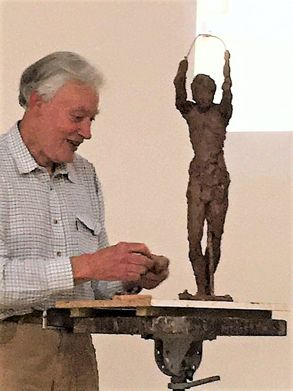
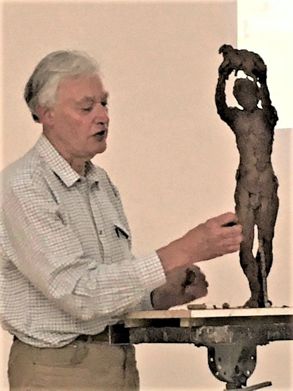
Rodney came and talked to us about a commission he is currently working on for two statues for the St John Baptist Church in Cirencester. As he talked he built up a maquette of one of the two statues, John the Baptist holding aloft a lamb - Rodney is a farmer as well as an artist - but equally, he suggested, the lamb could be seen as the Lamb of God. The clay Rodney uses is a red clay which for him gives more of a feeling for the bronze effect of the final product than the grey clay used by most sculptors. Rodney demonstrated how he can gently twist the emerging figure around its flexible armature to explore ways of creating the feeling of movement he strives to impart to all his work.
When he is happy with the maquette Rodney is able to discuss further his ideas with the commissioning committee, before starting work on the on the full sized figure. We were shown slides of how the finished clay figure is painted with several layers of a rubber solution that when set form a surrounding hard skin. The skin is then cut lengthways to form two mounds; the clay core is removed and a liquid bronze or resin poured into the moulds to form the two halves that will be combined to form the final sculpture. The mounds can be re-used, as was the case with a statue of St Edmond Rodney created for St Edmond’s church in Abingdon, and subsequently re-cast for St Edmond’s College in Cambridge and for St Edmond’s School near Ware.
The St John figure will be 2.2 metres tall and occupy a shallow external niche halfway up the St John Church tower, several metres above the viewer. Rodney will make the upper half of the statue’s body proportionately longer than natural to give people standing below the installed figure the impression of a fully proportioned work.
Rodney was warmly thanked for the talk and demonstration which provided an excellent illustration of what goes into the creation of a full scale work of sculptural art.
Workshop - An Evening of Heads
13th October 2020
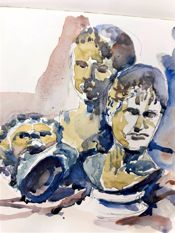
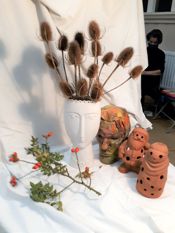
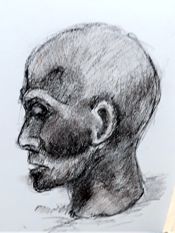
This proved to be a most enjoyable evening. Still life often presents the problem of how to make it interesting and challenging. An assortment of borrowed stone heads from a rather grand garden did the trick together with a few hips, berries and teasels for good measure. Many Members brought further varied and interesting heads and indeed there was almost one each.
The still life groups were set up beautifully with proper lighting etc. and the colourful display of artworks below illustrates a wide range of media and technique.
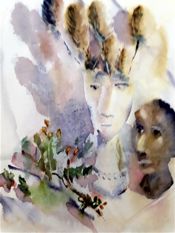
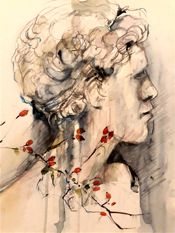
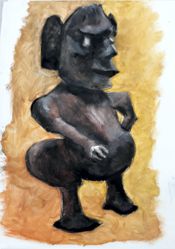

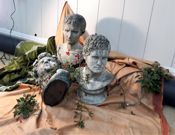
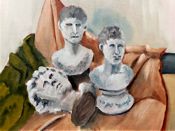
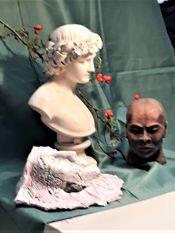

Archive PROGRAMMES
Winter 2020-2021 programme
Summer 2020 programme
